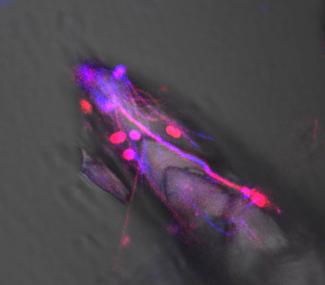Billion Times Faster: The rate of hot-spring travertine (CaCO3) deposition at Mammoth Hot Springs in Yellowstone National Park is accelerated (catalyzed), reaching crystal growth rates one billion times faster than the rate of CaCO3 deposition in lakes, caves, rivers and oceans around the world. This astonishing rate of precipitation, which amounts to 1 ton of travertine being deposited each day at Mammoth, is driven by the biomolecules produced by heat-loving bacteria (thermophiles) that thrive in the hot springs. This image, which merges transmitted plane-light (brightfield) with Airyscan Superresolution autofluorescence, shows a rapidly extending travertine crystal intimately associated with thermophilic sulfide oxidizing bacterial filaments (Sulfurihydrogenibium yellowstonense) and unknown rod-to-coccoid shaped bacteria.
